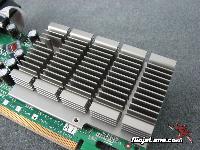After careful consideration I have decided to transfer all hardware review activities to a new domain. I purchased Hardwareasylum.com in 2012 and have been working hard to build a new and improved Ninjalane on that domain. If you are reading this you have reached one of the archived articles, news, projects and/or reviews that were left behind during the site migration.
Please update your bookmarks and be sure to visit the new and improved Ninjalane at Hardwareasylum.com
Leadtek WinFast PX8400 GS TDH Silent Review
Author: Dennis Garcia
Published: Sunday, September 16, 2007
Passive Heatsink
Lets take a closer look at that heatsink.
The Leadtek passive heatsink appears to be an extruded part given the uniform geometry and one-way design. A machine process finished off the heatsink by cutting the vertical grooves and making way for the mounting hardware. The heatsink is attached using 2 mounting screws with the attachment nuts being pressed into the aluminum.
The Leadtek passive heatsink appears to be an extruded part given the uniform geometry and one-way design. A machine process finished off the heatsink by cutting the vertical grooves and making way for the mounting hardware. The heatsink is attached using 2 mounting screws with the attachment nuts being pressed into the aluminum.
The heatsink features a grey anodized finish with the Leadtek logo having been sand blasted into place.
Heatsink Tests
In the HTPC world silence is the name of the game and while most modern computer components require a fan to keep them cool it's nice to see mfgs experimenting with alternative cooling methods. The fundamental downside to a fanless heatsink is the build-up of excess heat in a concentrated space. So, we experimented with a couple different scenarios to see how they affected surface temperature.
The first setup was an open case with only the CPU fan running, there was a PSU fan as well however in an open air environment these fans have little to no effect on airflow. The CPU fan was close enough to the video card to be effected. Sadly the effect was reverse of what we wanted. After a short time the slow moving CPU fan began to react to a rise in ambient temperature and started spinning faster until it was almost at full speed.. This is normal under gaming conditions however our tests were done while the system was at idle.
Our next setup was to simulate an additional case fan pointed directly at the expansion slots and in the traditional location just under the HDDs. The additional fan prevented the CPU from spinning up like before but did introduce an additional level of noise that rivaled that of your typical GPU fan. The only advantage here is that the fan can be easily replaced when it wears out or gets gummed up with dust and lint.
Temps
WinFox II reported GPU temperatures at a cool 62C in our first test. Heatsink surface temperature was between 45C and 52C depending on where the IR was pointed. Despite the rather high temperatures the system remained completely stable throughout our series of benchmarks and midnight gaming sessions.
In our second test GPU temperatures dropped considerably going from 62C down to 43C with heatsink surface temps being about the same. The moral of the story here is to ensure that whatever case you choose make sure there is adequate and free airflow across the cards and CPU. This will provided you with the longest life and least amount of additional noise.
The first setup was an open case with only the CPU fan running, there was a PSU fan as well however in an open air environment these fans have little to no effect on airflow. The CPU fan was close enough to the video card to be effected. Sadly the effect was reverse of what we wanted. After a short time the slow moving CPU fan began to react to a rise in ambient temperature and started spinning faster until it was almost at full speed.. This is normal under gaming conditions however our tests were done while the system was at idle.
Our next setup was to simulate an additional case fan pointed directly at the expansion slots and in the traditional location just under the HDDs. The additional fan prevented the CPU from spinning up like before but did introduce an additional level of noise that rivaled that of your typical GPU fan. The only advantage here is that the fan can be easily replaced when it wears out or gets gummed up with dust and lint.
Temps
WinFox II reported GPU temperatures at a cool 62C in our first test. Heatsink surface temperature was between 45C and 52C depending on where the IR was pointed. Despite the rather high temperatures the system remained completely stable throughout our series of benchmarks and midnight gaming sessions.
In our second test GPU temperatures dropped considerably going from 62C down to 43C with heatsink surface temps being about the same. The moral of the story here is to ensure that whatever case you choose make sure there is adequate and free airflow across the cards and CPU. This will provided you with the longest life and least amount of additional noise.





